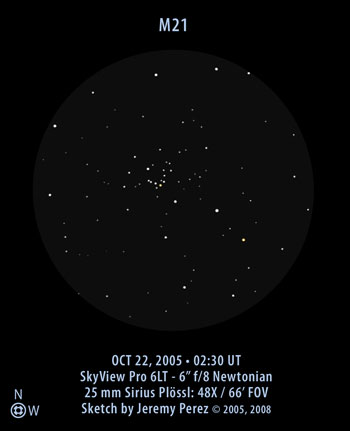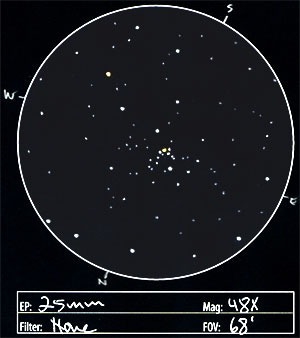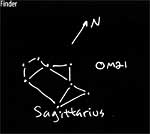
Click image for larger version.
The above sketch is an update to the original to clean it up, scale down fainter stars, and update formatting. The original is shown below.

Observation Notes:
 I spotted this open cluster in the 1.4° wide field of my 32 mm eyepiece, where it shared the view with M20. I sketched with the tighter field of my 25 mm eyepiece, so M20 is just out of view to the south-southwest. Light pollution was being pretty naughty and the cluster wasn’t at its best. Some color was flickering in and out with the turbulent air. What I saw was sparse enough that a general shape wasn’t evident. The core region was elongated north-northwest to south-southeast.
I spotted this open cluster in the 1.4° wide field of my 32 mm eyepiece, where it shared the view with M20. I sketched with the tighter field of my 25 mm eyepiece, so M20 is just out of view to the south-southwest. Light pollution was being pretty naughty and the cluster wasn’t at its best. Some color was flickering in and out with the turbulent air. What I saw was sparse enough that a general shape wasn’t evident. The core region was elongated north-northwest to south-southeast.
Object Information:
This open cluster has a Trumpler class of I3m, and since it contains bright giant stars of type B0, it is very young. It has an estimated age of 4.6 million years and contains at least 57 stars. Its distance is anywhere from 2200 light years (Burnham) to 4250 light years (K.G. Jones/Sky Catalog 2000).
M21 was discovered by Charles Messier in 1764.
| Subject | M21 (NGC 6531) |
| Classification | Open Cluster (Type d) |
| Position* | Sagittarius [RA: 18:04:36 / Dec: -22:30:00] |
| Size* | 13.0′ |
| Brightness* | 6.5 |
| Date/Time | October 21, 2005 – 7:30 PM (October 22, 2005 – 02:30 UT) |
| Observing Loc. | Flagstaff, AZ – Home |
| Instrument | Orion SVP 6LT Reflector (150 mm dia./1200 mm F/L) |
| Eyepieces/Mag. | 25 mm (48X) |
| Conditions | Clear, calm, 55°F |
| Seeing | 3/10 Pickering |
| Transparency | Mag 4.7 NELM (based on 4-Sagittarius) |
| Sources | SEDS |
*Based on published data.